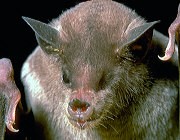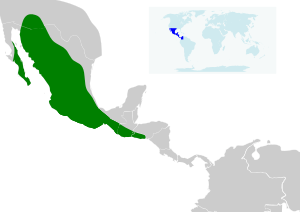Lesser long-nosed bat facts for kids
Quick facts for kids Lesser long-nosed bat |
|
|---|---|
 |
|
| Conservation status | |
| Scientific classification | |
| Genus: |
Leptonycteris
|
| Species: |
yerbabuenae
|
 |
|
| Synonyms | |
|
L. nivalis yerbabuenae |
|
The lesser long-nosed bat (Leptonycteris yerbabuenae) is a medium-sized bat found in Central and North America. People sometimes call it Sanborn's long-nosed bat or the Mexican long-nosed bat. However, the name "Mexican long-nosed bat" can be confusing. It is also used for all bats in the Leptonycteris group and for another species, the greater long-nosed bat.
This bat was first thought to be a type of greater long-nosed bat. Later, it was considered a type of southern long-nosed bat. Now, scientists agree it is its own unique species. Bat fans often call them "leptos" because they are the most well-known bats in their group. The scientific name comes from Yerbabuena, a place in Guerrero, Mexico, where this bat was first found.
Contents
What Does the Lesser Long-Nosed Bat Look Like?
Lesser long-nosed bats are fairly small. Adults are about 8 centimeters (3 inches) long. They weigh between 15 and 25 grams (0.5 to 0.9 ounces). Males and females are about the same size. It is hard to tell them apart just by looking.
As their name suggests, they have a long, thin snout. At the end of their snout is a small, triangle-shaped nose-leaf. Even though they have small bones that look like a tail inside, they do not have a tail you can see.
This bat's tongue is special for drinking nectar. It has long ridges and rough, cone-shaped bumps. These bumps might also help clean their teeth. Their wings are strong for flying long distances. This helps them fly easily in open areas. However, it makes them less able to turn quickly.
Only three other bat species in North America have a nose-leaf. Two of these, the Mexican long-tongued bat and the California leaf-nosed bat, have a clear tail. The California leaf-nosed bat also has much bigger ears. Lesser long-nosed bats are most often confused with their close relatives, the greater long-nosed bats. But greater long-nosed bats are about 10% bigger. They also have shorter, grayish fur and longer wings.
Adult lesser long-nosed bats have yellow-brown or gray fur on their backs. Their fur is rusty brown underneath. They have small ears.
Where Do Lesser Long-Nosed Bats Live?
Lesser long-nosed bats live in dry grasslands, scrub, or forest areas. They prefer places below about 550 meters (1,800 feet) in height. They can handle very hot temperatures, up to 41°C (106°F). This is partly because their bodies use energy slowly. They do not go into a deep sleep (torpor) or hibernation. They will die if the temperature drops below about 10°C (50°F).
In the northern parts of their range, they reach southern California, Arizona, and New Mexico. However, they only visit these areas in the summer. They arrive between April and July and fly south again in September. Some bats may travel as far as 1,600 kilometers (1,000 miles) each year. Their travel paths follow where their food plants are available. They look for cactus plants, Agave, and other special plants.
These bats live all year in western and southern Mexico. They are also found along the east coast of Mexico. Their range extends into Guatemala, El Salvador, and Honduras. There are no different types (subspecies) of lesser long-nosed bats known.
Diet and Behavior
Lesser long-nosed bats mostly eat nectar from plants that bloom at night. These plants include saguaro and Organ pipe cactus. They also feed on century plant and other agaves. These bats are very important for helping night-blooming cacti make seeds. They sometimes eat cactus fruits too. In winter, they might eat pollen from other plants if they find it.
During the day, lesser long-nosed bats rest in large groups. These groups can have thousands of bats. They roost in caves or old mines. At night, they fly out to find food. The size of these groups changes throughout the year. This happens as the bats travel to their summer feeding grounds. At certain times, many roosts are only used by mother bats and their babies. The male bats stay in smaller, temporary roosts.
Reproduction and Life Cycle
The breeding season for bats that fly north in the summer is from November to December. For bats that stay in the south, it is from May to June. Even though there are two different breeding times, each bat only mates once a year.
A mother bat is pregnant for about six months. She gives birth to one baby bat. This usually happens when there are lots of flowers available for food. Newborn bats weigh between 4 and 7 grams (0.14 to 0.25 ounces). They drink their mother's milk for four to eight weeks. They can fly after about one month. However, they do not start leaving the maternity cave for another two to three weeks. These bats are known to live for at least eight years in the wild.
See also
 In Spanish: Murciélago magueyero menor para niños
In Spanish: Murciélago magueyero menor para niños
Images for kids




